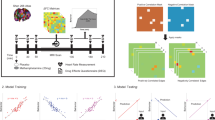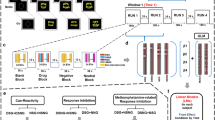Abstract
Drug-associated cues elicit conditioned responses in human drug users, and are thought to facilitate a drug-seeking behavior. Yet, little is known about how these associations are acquired, or about the specificity of the conditioned response modalities. In this study, healthy, nondependent volunteers (N=90) completed a conditioning paradigm in which they received a moderate dose of methamphetamine paired with one stimulus and placebo with another stimulus, each on two separate occasions. Their responses to these cues were measured with a behavioral preference, self-reported ‘liking’, emotional reactivity, and attentional bias measures, both before and after the conditioning. Following the conditioning procedure, subjects exhibited a behavioral preference, positive emotional reactivity, and attentional bias toward the methamphetamine-associated cue, compared with the placebo stimulus. In addition, subjects who reported greater positive subjective drug effects during the conditioning displayed a more robust conditioning. This work demonstrates that healthy nondependent volunteers readily acquire conditioned responses to neutral stimuli paired with a drug. The procedure has significant value to study individual variation in acquisition of conditioned responses as a possible risk factor for drug taking, and to study the neural basis of conditioned drug responses.
Similar content being viewed by others
Log in or create a free account to read this content
Gain free access to this article, as well as selected content from this journal and more on nature.com
or
References
Bradley MM, Lang PJ, Cuthbert BN (1993). Emotion, novelty, and the start reflex: habituation in humans. Behav Neurosci 107: 970–980.
Childress AR, Mozley PD, McElgin W, Fitzgerald J, Reivich M, O’Brien CP (1999). Limbic activation during cue-induced cocaine craving. Am J Psychiatry 156: 11–18.
Childress AR, Erhman RN, Wang Z, Li Y, Sciortino N, Hakun J et al (2008). Prelude to passion: limbic activation by ‘unseen’ drug and sexual cues. PLoS One 3: e1506.
Childs E, de Wit H (2009). Amphetamine-induced place preference in humans. Biol Psychiatry 65: 900–904.
Childs E, de Wit H (2011). Contextual conditioning enhances the psychostimulant and incentive properties of d-amphetamine in humans. Addict Biol 18: 985–992.
Cook CE, Jeffcoat AR, Sadler BM, Hill JM, Voyksner RD, Pugh DE et al (1992). Pharmacokinetics of oral methamphetamine and effects of repeated daily dosing in humans. Drug Metab Dispos 20: 856–862.
Drobes DJ, Tiffany ST (1997). Induction of smoking urge through imaginal and in vivo procedures: physiological and self-report manifestations. J Abnorm Psychol 106: 15–25.
Ehrman R, Robbins SJ, Childress AR, O’Brien CP (1992). Conditioned responses to cocaine-related stimuli in cocaine abuse patients. Psychopharmacology (Berl) 107: 523–529.
Field M, Cox WM (2008). Attentional bias in addictive behaviors: a review of its development, causes, and consequences. Drug Alcohol Depend 97: 1–20.
Franken IH (2003). Drug craving and addiction: integrating psychophysiological and neuropsychopharmacological approaches. Prog Neuropsychopharmacol Biol Psychiatry 27: 563–579.
Geier A, Mucha RF, Pauli P (2000). Appetitive nature of drug cues confirmed with physiological measures in a model using pictures of smoking. Psychopharmacology 150: 283–291.
Johanson CE, Uhlenhuth EH (1980). Drug preference and mood in humans: d-amphetamine. Psychopharmacology (Berl) 71 p 275–279.
Kalivas PW, Volkow ND (2005). The neural basis of addiction: a pathology of motivation and choice. Am J Psychiatry 162: 1403–1413.
Koob GF, Le Moal M (2008). Neurobiological mechanisms for opponent motivational processes in addiction. Philos Trans R Soc Lond B Biol Sci 363: 3113–3123.
Lang PJ, Greenwalk MK, Bradley MM, Hamm AO (1993). Looking at pictures: affective, facial, visceral, and behavioral reactions. Psychophysiology 30: 261–273.
Martin WR, Sloan JW, Sapira JD, Jasinski DR (1971). Physiologic, subjective, and behavioral effects of amphetamine, methamphetamine, ephedrine, phenmetrazine, and methylphenidate in man. Clin Pharm Ther 12: 245–258.
Mayo LM, Fraser D, Childs E, Momenan R, Hommer DW, Heilig M (2013). Conditioned preference to a methamphetamine-associated contextual cue in humans. Neuropsychopharmacology 38: 921–929.
McNair D, Lorr M, Droppleman L. (1971) Profile of Mood States. Educational and Industrial Testing Service: San Diego, CA.
O’Brien CP, Childress AR, McLellan AT, Herman R (1992). Classical conditioning in drug-dependent humans. Ann NY Acad Sci 654: 400–415.
Perkins KA, Epstein LH, Grobe J, Fonte C (1994). Tobacco abstinence, smoking cues, and the reinforcing value of smoking. Pharmacol Biochem Behav 47: 107–112.
Robinson TE, Berridge KC (2008). Review. The incentive sensitization theory of addiction: some current issues. Philos Trans R Soc Lond B Biol Sci 363: 3137–3146.
Rohsenow DJ, Monti PM (1999). Does urge to drink predict relapse after treatment? Alcohol Res Health 23: 225–232.
Schuster CR, Johanson CE (1988). Relationship between the discriminative stimulus properties and subjective effects of drugs. Psychopharmacol Ser 4: 161–175.
Skinner MD, Auben HJ (2010). Craving’s place in addiction theory: contributions of the major models. Neurosci Biobehav Rev 34: 606–623.
Tiffany ST, Carter BL (1998). Is craving the source of compulsive drug use? J Psychopharmacol 12: 23–30.
Wardle MC, Garner MJ, Munafo ME, de Wit H (2012). Amphetamine as a social drug: effects of d-amphetamine on social processing and behavior. Psychopharmacology (Berl) 223: 199–210.
Waters AJ, Shiffman S, Sayette MA, Paty JA, Gwaltney CJ, Balabanis MH (2003). Attentional bias predicts outcome in smoking cessation. Health Psychol 22: 378–387.
White TL, Justice AJ, de Wit H (2002). Differential subjective effects of D-amphetamine by gender, hormone levels and menstrual cycle phase. Pharmacol Biochem Behav 73: 729–741.
Winkielman P, Berridge KC, Wilbarger JL (2005). Unconscious affective reactions to makes happy versus angry faces influence consumption behavior and judgments of value. Pers Soc Psychol Bull 31: 121–135.
Winkler MH, Weyers P, Mucha RF, Stippekohl B, Stark R, Pauli P (2011). Conditioned cues for smoking elicit preparatory responses in healthy smokers. Psychopharmacology 231: 781–789.
Acknowledgements
We gratefully acknowledge Markus Heilig for his valuable intellectual contributions and technical support of this research.
Author information
Authors and Affiliations
Corresponding author
Rights and permissions
About this article
Cite this article
Mayo, L., de Wit, H. Acquisition of Responses to a Methamphetamine-Associated Cue in Healthy Humans: Self-Report, Behavioral, and Psychophysiological Measures. Neuropsychopharmacol 40, 1734–1741 (2015). https://doi.org/10.1038/npp.2015.21
Received:
Revised:
Accepted:
Published:
Issue date:
DOI: https://doi.org/10.1038/npp.2015.21
This article is cited by
-
Methamphetamine alters nucleus accumbens neural activation to monetary loss in healthy young adults
Psychopharmacology (2023)
-
Protective effects of elevated anandamide on stress and fear-related behaviors: translational evidence from humans and mice
Molecular Psychiatry (2020)
-
Effects of methamphetamine on neural responses to visual stimuli
Psychopharmacology (2019)
-
Gender differences in the behavioral and subjective effects of methamphetamine in healthy humans
Psychopharmacology (2019)
-
Neural activation to monetary reward is associated with amphetamine reward sensitivity
Neuropsychopharmacology (2018)



